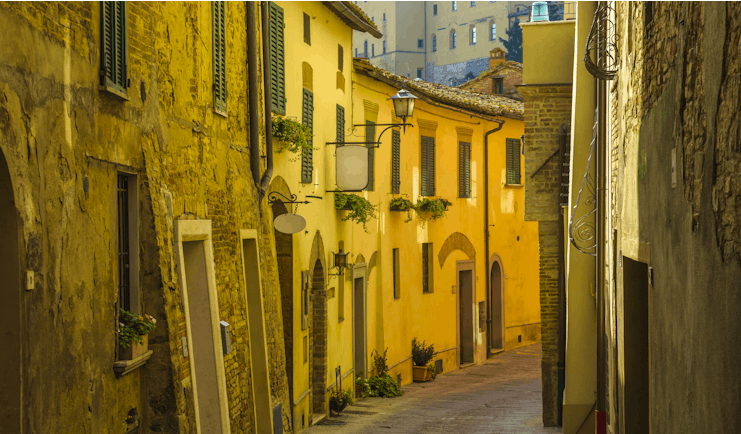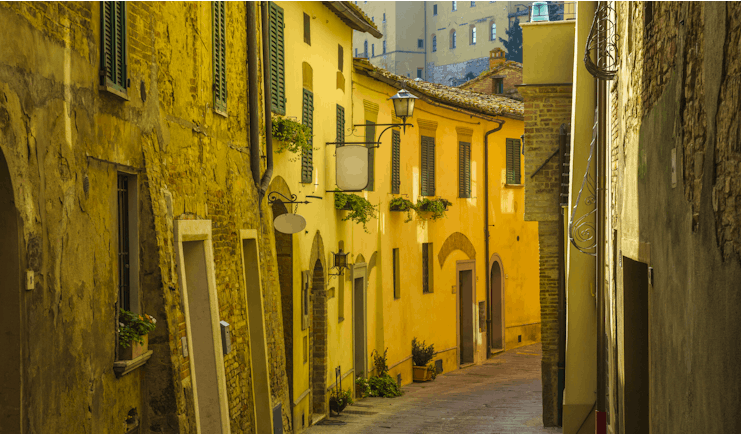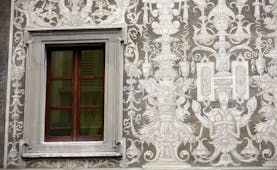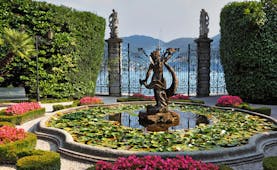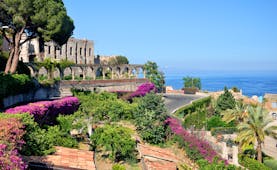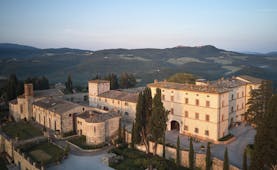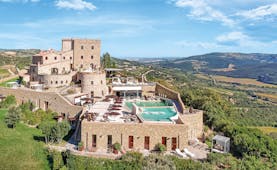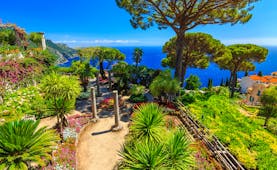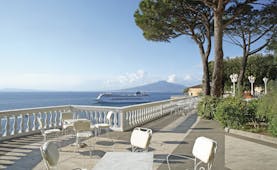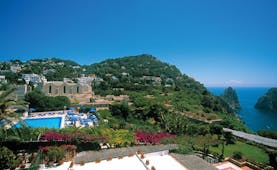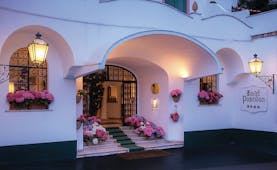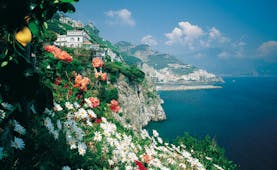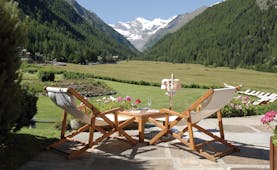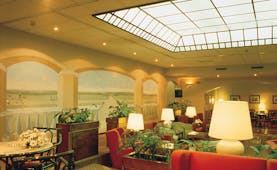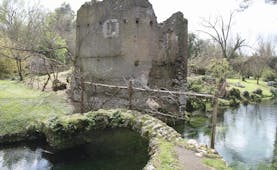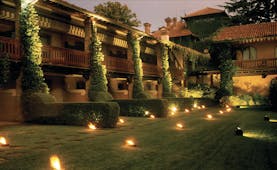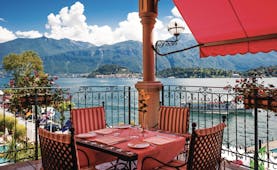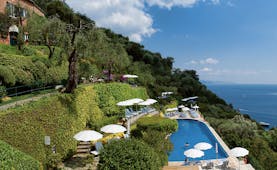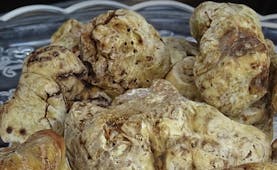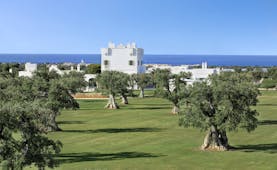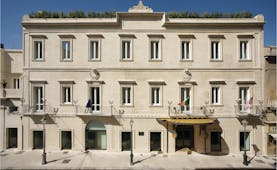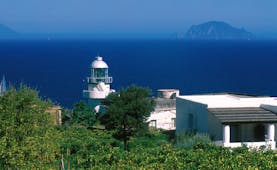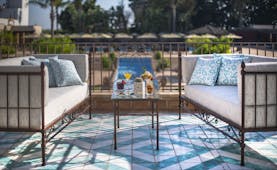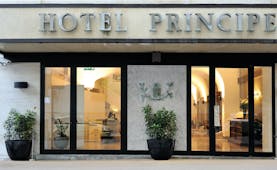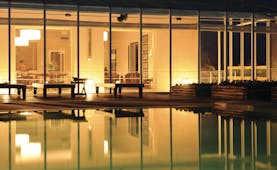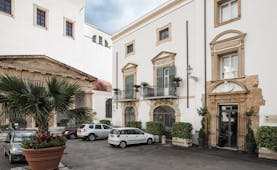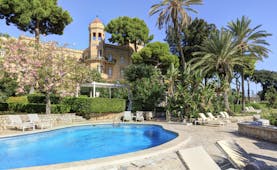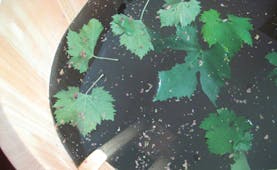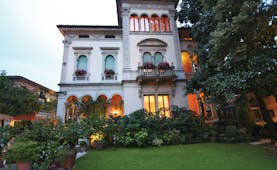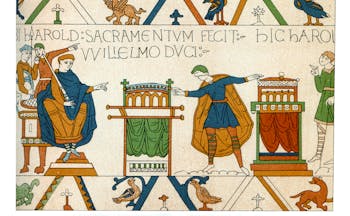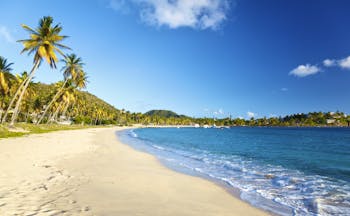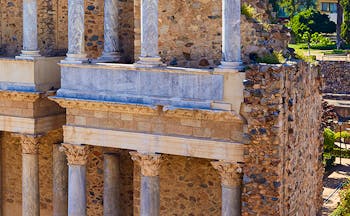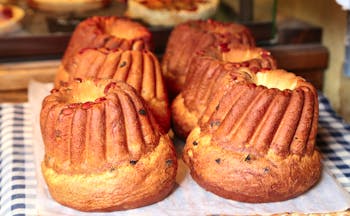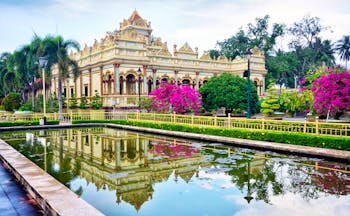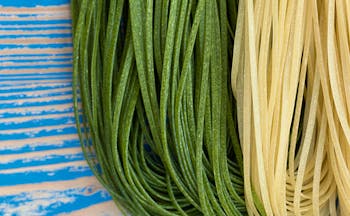Luxury Italy fly-drive tailor-made touring holiday Under the Tuscan Sun
This luxury Italian fly-drive holiday begins at Pisa where you pick up your hire-car to drive the short distance to the walled town of Lucca. Its distinctive shape and green streets add a romantic aspect to this historic town. Lucca is a delightful, walled town with streets of distinctive buildings. From Lucca you drive to Florence, skirting the spa and thermal towns of Montecatini Terme and Monsummano Terme. Your base for the next two nights is on the edge of Florence, at Candeli overlooking the River Arno. You have a full day to explore the delights of Florence, before continuing your journey south into the Chianti region. You have four nights here giving ample time to explore the region including the nearby city of Siena with its narrow streets, campo, cathedral and gardens. Then journey via Arezzo to your next stop on the edge of the Tuscany-Umbria border, just outside the Etruscan town of Cortona. You stay on a wine-estate here. From Cortona you drive across the rolling fields and wooded hills of southern Tuscany, through the fine towns of Montepulciano and Pienza before reaching the delightful town of Montalcino, at the heart of the Brunello vineyards. Your final stop is on the Tuscan coast near Castiglione della Pescaia, noted for its long sandy beaches, flanked by umbrella pines. This part of Tuscany, the Maremma, is also known for its nature reserves. All in all you will have had a thoroughly Tuscan travel experience. You fly back from Pisa.
Highlights
Lucca • Florence • Siena • Chianti classico • Cortona • Montalcino • Maremma • Garden visits at Lucca and near Siena • Vineyard visits in Chianti and Montalcino • Wealth of museums and galleries to visit
Day by day
After collecting your hire-car on arrival at Pisa airport, drive to Lucca. Lucca is distinctive due to the well-preserved Renaissance walls that surround the town centre, all topped with pathways and rows of trees. Spend your first morning taking in the extraordinary shape of the town via these pretty pathways, with the Appuan Alps and Apennines as your backdrop. The former of these two sets of mountains is known for the particularly dramatic jagged form of its rocks, as well as the high-quality marble that is sourced there. The evidence of Lucca’s history continues inside its walls. The Guinigi Tower is all that remains of the Case Guinigi, a complex of mansions and towers that once belonged to the Guinigi family. This tower is now topped with seven holm-oaks, ensuring that it blends in with the green outer walls. From the top of this tower, visitors can appreciate the town’s unusual shape, the rolling green countryside, and the dynamic mountains more fully. Lucca is also the proud owner of a 459-arch aqueduct, designed by Lorenzo Nottolini, which extends over 3km and once brought water to Lucca from the mountains. The Duomo di San Martino dates from the 6th century, and still bears something of the style of its ancient beginnings, though it was added to in the Romanesque style in the 11th century. In the centre of the town, the Piazza del Mercato preserves the shape of the amphitheatre which once sat in its place. The local speciality olive oil, olio d’oliva lucchese, can be tasted in various localities in the town.
Situated just on the outskirts of Florence, Villa la Massa is ideally placed for exploration of Tuscany’s capital and occupying a peaceful location on the banks of the River Arno. On your full day here, explore Florence. Visit the 13th century Gothic cathedral with its iconic red dome, the hexagonal baptistery with its famous golden Gates of Paradise, and the cathedral’s museum, beautifully grand, before delving into Florence’s artistic heritage. Numerous art galleries and art museums line the streets of Florence; the Palazzo Pitti gallery is housed in a vast Renaissance palace, while the Uffizi Art Museum and the Bargello sculpture gallery have gained international repute. The various churches and monasteries in and around Florence also exhibit many examples of Florentine painting from all ages. The Ponte Vecchio is a mediaeval bridge that supports a row of jewellery shops. The artistic highlight of a visit to Florence, however, is Michelangelo’s original ‘David’, which is on display at the Galleria dell’Accademia. To finish off the day in the city, perhaps dine either at La Cucina, or at the double Michelin-starred Enoteca Pinchiorri.
It's an easy drive south out of Florence today and from the Arno valley you are soon in the hills of the Chianti region, and their shades of green from oak, cypress, pine and olive trees. You pass through pretty villages, the patchwork of vineyards and will glimpse ruined fortifications on hillsides.
You have two more days based here in the Chianti region allowing for a combination of relaxing at your hotel, perhaps exploring the nearby countryside on foot, or continuing your exploration of the region by car, perhaps visiting the Castello di Brolio, the wine villages of Gaiole and Radda, nearby Volterra or the enclosed mediaeval town of San Gimignano. There are also private gardens and wineries in the area.
From Chianti we suggest a slight detour to the eastern part of Chianti to visit Arezzo. Arezzo is home to the mediaeval Piazza Grande. Here, sip coffee in a pavement café while watching the artists at work. Twice a year, a historic joust takes place in this square, accompanied by costumed parades and competitions, which casts a becoming medieval light back on the town. As you relax in the square, you can observe the attraction of the back of the Santa Maria dell Pieve, its large bell tower, and the 4 layers of arches that define its façade. On Sundays, the streets of Arezzo bustle due to the Antiquary Market. The windows of the Duomo San Donato are still covered with glass dating back to medieval Italy; this imposing building, grand despite its minimalist exterior detail, has a warm regal charm that suits the Arezzo atmosphere. If time permits, continue your tour of the town to the mediaeval fortress, the Roman Amphitheatre, and the early Renaissance frescos in the Church of San Francesco. Your next stop for two nights is outside Cortona on the Barachi wine estate. On the full day in this region, you could tour the vineyards owned by the Barachi, rest by the pool and enjoy the fine dining at the hotel. Cortona itself is an historic centre with very important Etruscan remains. Or, just to the south there are two options, but not in Tuscany! Here you are right on the border with Umbria, so two excursions for today are in the neighbouring province. Perugia is one option and Lake Trasimeno is the other.
The drive from Cortona to Montalcino is beautiful. You pass through the hills and fields of southern Tuscany before they suddenly become vineyards too. There are two notable stops you can make today: the first is Montepulciano and the second is Pienza. Then you reach Montalcino itself. This is a quintessential Tuscan small town: perched on a hilltop, with a beautiful castle at its highest point, and with a famous wine that takes its name. You have a full day here which can be spent sightseeing in Montalcino, seeking out the best wine-tasting spots and choosing fine ceramics in the shops. Brunello di Montalcino is a wine known for its notes of spice, earth, leather, raisins, cedar, and cherry (afforded by its content of Sangiovese grapes). The Ciacci Piccolomini d’Aragona is situated in a much more secluded location and should be open for wine-tasting sessions. On occasion, to add an element of eccentricity to your trip, you will be able to visit the estate’s wolves. The 12th century Castello Romitorio offers tastings of the Brunello wines, as well as tours of the vineyards, farm house, fortress, and art gallery. You may wish to plan for your stop in Montalcino to fall on a Sunday, to allow you to witness the morning Gregorian chant mass at the Abbazia di Sant’Antimo. This moving and captivating tradition is an experience of a lifetime, the chants acoustically enhanced by the curved stone walls, but you may also wish to remain in the abbey after the service to witness the building at its most peaceful. In the evenings, dine at your hotel and enjoy some more of the Brunello wine out on the terrace under the stars.
Your final stop on this touring holiday takes you to Tuscany’s coast, cradled between the blue of the Tyrrhenian Sea and the vibrant green of dense pine forests. Castiglione della Pescaia gets its name from its origins as a mediaeval fortress and a large fishery, and sits at the mouth of the Fiume Bruna, now lined with harboured ships, small businesses, and cafes. The pastel-coloured buildings, winding grape vines, and solid oak trees give Castiglione della Pescaia the nickname of ‘Switzerland of the Maremma’. The beaches are known for being some of the cleanest in Tuscany, with tranquil clear waters and silky stretches of golden sand. In the town, the Palazzo Centurioni, possibly dating back to the 15th century, is the oldest building and was formerly the ancient tribunal house. The Chiesa di Sant’Battista dates back to the 16th century and now houses some incredibly valuable relics associated with the city’s patron saint. Perhaps spend a day further inland in Grosseto, exploring the awe-inspiring Scavi Archeologici di Roselle, or simply watching the world go by on the Piazza Dante.. Alternatively, wander inland into the rare ecosystem of the Riserva Naturale Diaccia Botrona for long walks beside the marshlands and reservoirs, or to watch the birdlife, from herons and kingfishers to haughty pink flamingos. On the last weekends of June, July, and August, Castiglione della Pescaia really comes alive with La Notte Bianca. Featuring late night music, art exhibitions, sailing tournaments, and dance competitions, it is the most thrilling time to be in Castiglione della Pescaia.
A short route from Castiglione della Pescaia to Pisa can be taken inland, but we would highly recommend the longer, more scenic coastal road. Use this final drive to commit to memory the delights of the natural landscape you have witnessed on your trip, passing rolling vineyards, deep blue seas, and those iconic hilltop Tuscan villages.
I just wanted to get in touch to say thank you! We have now returned from our Orient Express, Venice trip, and it could not have been better. The memories made will last a life time. Obviously, the train experience is beyond words and Venice is such a fantastic place, but we wanted to specifically thank you for the organisation and assistance. Your attention to detail is superb and it made everything smooth and easy. Thank you again for a job extremely well done.Mrs C, May, 2024
Holiday price guide Prices from about £4,220 per person based on two people sharing a double or twin room.
Holiday Code ITFD11
Call us on 01392 441245
Luxury Italy fly-drive tailor-made touring holiday Under the Tuscan Sun
After collecting your hire-car on arrival at Pisa airport, drive to Lucca. Lucca is distinctive due to the well-preserved Renaissance walls that surround the town centre, all topped with pathways and rows of trees. Spend your first morning taking in the extraordinary shape of the town via these pretty pathways, with the Appuan Alps and Apennines as your backdrop. The former of these two sets of mountains is known for the particularly dramatic jagged form of its rocks, as well as the high-quality marble that is sourced there. The evidence of Lucca’s history continues inside its walls. The Guinigi Tower is all that remains of the Case Guinigi, a complex of mansions and towers that once belonged to the Guinigi family. This tower is now topped with seven holm-oaks, ensuring that it blends in with the green outer walls. From the top of this tower, visitors can appreciate the town’s unusual shape, the rolling green countryside, and the dynamic mountains more fully. Lucca is also the proud owner of a 459-arch aqueduct, designed by Lorenzo Nottolini, which extends over 3km and once brought water to Lucca from the mountains. The Duomo di San Martino dates from the 6th century, and still bears something of the style of its ancient beginnings, though it was added to in the Romanesque style in the 11th century. In the centre of the town, the Piazza del Mercato preserves the shape of the amphitheatre which once sat in its place. The local speciality olive oil, olio d’oliva lucchese, can be tasted in various localities in the town.
Situated just on the outskirts of Florence, Villa la Massa is ideally placed for exploration of Tuscany’s capital and occupying a peaceful location on the banks of the River Arno. On your full day here, explore Florence. Visit the 13th century Gothic cathedral with its iconic red dome, the hexagonal baptistery with its famous golden Gates of Paradise, and the cathedral’s museum, beautifully grand, before delving into Florence’s artistic heritage. Numerous art galleries and art museums line the streets of Florence; the Palazzo Pitti gallery is housed in a vast Renaissance palace, while the Uffizi Art Museum and the Bargello sculpture gallery have gained international repute. The various churches and monasteries in and around Florence also exhibit many examples of Florentine painting from all ages. The Ponte Vecchio is a mediaeval bridge that supports a row of jewellery shops. The artistic highlight of a visit to Florence, however, is Michelangelo’s original ‘David’, which is on display at the Galleria dell’Accademia. To finish off the day in the city, perhaps dine either at La Cucina, or at the double Michelin-starred Enoteca Pinchiorri.
It's an easy drive south out of Florence today and from the Arno valley you are soon in the hills of the Chianti region, and their shades of green from oak, cypress, pine and olive trees. You pass through pretty villages, the patchwork of vineyards and will glimpse ruined fortifications on hillsides.
You have two more days based here in the Chianti region allowing for a combination of relaxing at your hotel, perhaps exploring the nearby countryside on foot, or continuing your exploration of the region by car, perhaps visiting the Castello di Brolio, the wine villages of Gaiole and Radda, nearby Volterra or the enclosed mediaeval town of San Gimignano. There are also private gardens and wineries in the area.
From Chianti we suggest a slight detour to the eastern part of Chianti to visit Arezzo. Arezzo is home to the mediaeval Piazza Grande. Here, sip coffee in a pavement café while watching the artists at work. Twice a year, a historic joust takes place in this square, accompanied by costumed parades and competitions, which casts a becoming medieval light back on the town. As you relax in the square, you can observe the attraction of the back of the Santa Maria dell Pieve, its large bell tower, and the 4 layers of arches that define its façade. On Sundays, the streets of Arezzo bustle due to the Antiquary Market. The windows of the Duomo San Donato are still covered with glass dating back to medieval Italy; this imposing building, grand despite its minimalist exterior detail, has a warm regal charm that suits the Arezzo atmosphere. If time permits, continue your tour of the town to the mediaeval fortress, the Roman Amphitheatre, and the early Renaissance frescos in the Church of San Francesco. Your next stop for two nights is outside Cortona on the Barachi wine estate. On the full day in this region, you could tour the vineyards owned by the Barachi, rest by the pool and enjoy the fine dining at the hotel. Cortona itself is an historic centre with very important Etruscan remains. Or, just to the south there are two options, but not in Tuscany! Here you are right on the border with Umbria, so two excursions for today are in the neighbouring province. Perugia is one option and Lake Trasimeno is the other.
The drive from Cortona to Montalcino is beautiful. You pass through the hills and fields of southern Tuscany before they suddenly become vineyards too. There are two notable stops you can make today: the first is Montepulciano and the second is Pienza. Then you reach Montalcino itself. This is a quintessential Tuscan small town: perched on a hilltop, with a beautiful castle at its highest point, and with a famous wine that takes its name. You have a full day here which can be spent sightseeing in Montalcino, seeking out the best wine-tasting spots and choosing fine ceramics in the shops. Brunello di Montalcino is a wine known for its notes of spice, earth, leather, raisins, cedar, and cherry (afforded by its content of Sangiovese grapes). The Ciacci Piccolomini d’Aragona is situated in a much more secluded location and should be open for wine-tasting sessions. On occasion, to add an element of eccentricity to your trip, you will be able to visit the estate’s wolves. The 12th century Castello Romitorio offers tastings of the Brunello wines, as well as tours of the vineyards, farm house, fortress, and art gallery. You may wish to plan for your stop in Montalcino to fall on a Sunday, to allow you to witness the morning Gregorian chant mass at the Abbazia di Sant’Antimo. This moving and captivating tradition is an experience of a lifetime, the chants acoustically enhanced by the curved stone walls, but you may also wish to remain in the abbey after the service to witness the building at its most peaceful. In the evenings, dine at your hotel and enjoy some more of the Brunello wine out on the terrace under the stars.
Your final stop on this touring holiday takes you to Tuscany’s coast, cradled between the blue of the Tyrrhenian Sea and the vibrant green of dense pine forests. Castiglione della Pescaia gets its name from its origins as a mediaeval fortress and a large fishery, and sits at the mouth of the Fiume Bruna, now lined with harboured ships, small businesses, and cafes. The pastel-coloured buildings, winding grape vines, and solid oak trees give Castiglione della Pescaia the nickname of ‘Switzerland of the Maremma’. The beaches are known for being some of the cleanest in Tuscany, with tranquil clear waters and silky stretches of golden sand. In the town, the Palazzo Centurioni, possibly dating back to the 15th century, is the oldest building and was formerly the ancient tribunal house. The Chiesa di Sant’Battista dates back to the 16th century and now houses some incredibly valuable relics associated with the city’s patron saint. Perhaps spend a day further inland in Grosseto, exploring the awe-inspiring Scavi Archeologici di Roselle, or simply watching the world go by on the Piazza Dante.. Alternatively, wander inland into the rare ecosystem of the Riserva Naturale Diaccia Botrona for long walks beside the marshlands and reservoirs, or to watch the birdlife, from herons and kingfishers to haughty pink flamingos. On the last weekends of June, July, and August, Castiglione della Pescaia really comes alive with La Notte Bianca. Featuring late night music, art exhibitions, sailing tournaments, and dance competitions, it is the most thrilling time to be in Castiglione della Pescaia.
A short route from Castiglione della Pescaia to Pisa can be taken inland, but we would highly recommend the longer, more scenic coastal road. Use this final drive to commit to memory the delights of the natural landscape you have witnessed on your trip, passing rolling vineyards, deep blue seas, and those iconic hilltop Tuscan villages.
I just wanted to get in touch to say thank you! We have now returned from our Orient Express, Venice trip, and it could not have been better. The memories made will last a life time. Obviously, the train experience is beyond words and Venice is such a fantastic place, but we wanted to specifically thank you for the organisation and assistance. Your attention to detail is superb and it made everything smooth and easy. Thank you again for a job extremely well done.Mrs C, May, 2024
Holiday price guide Prices from about £4,220 per person based on two people sharing a double or twin room.
Holiday Code ITFD11
Our prices include
● British Airways flights from London to Pisa return
● Hire of a Group B car for the duration of the holiday
● 2 nights’ bed and breakfast in a Superior double room at the San Luca Palace, in Lucca with parking
● 2 nights’ bed and breakfast in a Classic double room at Villa la Massa, near Florence
● 4 nights’ bed and breakfast in a Superior double room Castel Monastero, in Chianti Classico
● 2 nights’ bed and breakfast in a Classic double room at Il Falconiere, near Cortona
● 2 nights’ bed and breakfast in a Castle Junior Suite at Castello di Velona, near Montalcino
● 2 nights’ bed and breakfast in a Superior double room at L’Andana, near Castiglione della Pescaia
● Concierge service and Expressions Holidays regional helpful hints
Our prices do not include
● Early check-in or late check-out at any hotels (although we can arrange this on request at additional cost)
● Any other services not mentioned above, such as transfers and meals except breakfast at hotels
● Personal holiday insurance. This is essential, and cover should be in place from when you book the holiday.
● Local tourist tax, usually between Euros 1 and 3 per person per night, and payable locally to the hotel
Additional information
Driving times for this touring holiday
Pisa Airport to Lucca 50 minutes
Lucca to Candeli 1 hour 10 minutes
Candeli to Castelnuovo Berardenga 1 hour 10 minutes
Castelnuovo Berardenga to Cortona 1 hour
Cortona to Montalcino 1 hour 30 minutes
Montalcino to Castiglione della Pescaia 1 hour 15 minutes
Castiglione della Pescaia to Pisa Airport 1 hour 40 minutes
Call us on 01392 441245
Luxury Italy fly-drive tailor-made touring holiday Under the Tuscan Sun

Hotel San Luca Palace is an exclusive 4-star deluxe hotel in an excellent central location. Comfortable, traditional accommodation and friendly service make it an ideal base to explore the mediaeval city of Lucca.
Superior double room

Villa la Massa is an enchanting 5-star Renaissance villa in the midst of glorious countryside, yet only fifteen minutes from Florence. Gourmet cuisine, stunning grounds and rustic, elegant accommodation afford guests a truly relaxing and restorative retreat.
Classic double room

Castel Monastero is a luxurious village-resort with superb facilities. Sympathetically renovated from an ancient hamlet and monastery, this hotel blends original architectural features with excellent cuisine and service in order to create an authentic Tuscan experience.
Classic double room

Il Falconiere is an exclusive, charming country hotel in a beautiful rural location. Cuisine is certainly the main focus of this hotel, with a Michelin-starred restaurant, cooking classes, vineyard tours and wine tastings on offer.
Classic double room

The Castello di Velona is an enchanting hotel and a perfect place from which to explore southern Tuscany. The restaurant terrace boasts magnificent views over the Tuscan countryside, and the outdoor pool and pretty gardens create a peaceful atmosphere.
Castle junior suite

L'Andana is an exclusive 5-star hotel in a magnificent natural location. This luxurious hotel offers the ultimate in relaxation with excellent local cuisine, superb spa facilities and stylish accommodation in the Tuscan countryside.
Superior double room
I just wanted to get in touch to say thank you! We have now returned from our Orient Express, Venice trip, and it could not have been better. The memories made will last a life time. Obviously, the train experience is beyond words and Venice is such a fantastic place, but we wanted to specifically thank you for the organisation and assistance. Your attention to detail is superb and it made everything smooth and easy. Thank you again for a job extremely well done.Mrs C, May, 2024
Holiday price guide Prices from about £4,220 per person based on two people sharing a double or twin room.
Holiday Code ITFD11
Call us on 01392 441245
Luxury Italy fly-drive tailor-made touring holiday Under the Tuscan Sun
About Tuscany
An Expressions tailor-made holiday in Tuscany allows you to appreciate its classical landscape of rolling hills and vineyards dotted with olive and cypress trees, its misty green-grey mountains that are never too far distant, and hill-top towns of rich brown and gold stone houses. This combines with the beauty of the works of art contained in the towns and villages throughout Tuscany to create an inspirational union of the spirit and the senses. There is an intrinsic comfort in the supposed contrast between the delicacy of a Botticelli and the heartiness of Ribollita soup, yet both are typical of this fascinating region. As birthplace of the Renaissance, the impact of Tuscan and particularly Florentine traditions and culture on European heritage is fundamental to our way of life. In addition to the obvious attractions of the scenery of Chianti and the art cities of Florence and Siena, there are the less well-known regions south of Siena with its moon-like landscape of hills, the patchwork vineyards of Montalcino, the coastal marshlands of the Maremma, the spas of Montecatini and Saturnia, the islands of Elba and Giglio, and the Casentino with the source of the Arno and abundant mushroom crops. Wherever you travel on holiday in Tuscany, you will be inspired by the beauty of your surroundings and the way of life, which is quintessentially that of Italy too.
Highlights of Tuscany
Famous vineyards producing wines of Chianti Classico, Brunello di Montalcino, Vino Nobile di Montepulciano. Alabaster is produced in Volterra. Gold and silver are worked in Florence and the Ponte Vecchio is lined with jewellery shops. Marbled paper and stationery is a speciality of Florence. Ceramics and hand-painted majolica from raw terracotta from Impruneta to the glazed pottery of Siena are to be found throughout Tuscany. Lucca has traditionally produced silk and hand-woven fabrics. Leather goods including shoes, handbags and belts are to be found from market stalls to designer shops such as Gucci and Ferragamo. Interesting markets include the Mercato dell' Antiquariato which sells furniture from antiques to bric-a-brac in Arezzo on the first weekend of every month, in Pisa on the second weekend and in Lucca on the third weekend. The 'wild' Maremma is known for its long-horned white cattle and cowboys (butteri) and natural springs including Saturnia.
Cultural highlights of Tuscany
As birthplace of the Renaissance, Tuscany contains a wealth of treasures: Giotto`s Campanile and Brunelleschi`s Dome in Florence, the Tombs of Galileo and Michelangelo in Florence`s Santa Croce, Botticelli`s `Birth of Venus` and `Primavera` and the portraits of the Duke and Duchess of Urbino by Piero della Francesca in the Uffizi, Michelangelo`s `David` in the Accademia, the architecture of the Piazza della Signoria in Florence, `The Tuscan Maremma` painting by Giovanni Fattori in the Palazzo Pitti in Florence, the Piazza del Campo in Siena, `The Legend of the Cross` frescoes by Piero della Francesco in Arezzo, `The Creation` fresco by Bartolo di Fredi in the Collegiata in San Gimignano, Romanesque church of the Collegiata in San Quirico d`Orcia, 14th Century Fortezza of Montalcino, Renaissance masterpiece of the church of Madonna di San Biagio at Montepulciano, the abbey-church of Sant`Antimo, mediaeval Lucignano and the towers of San Gimignano, the Etruscan Museum in Cortona.
Festivals in Tuscany
Many of Tuscany`s festivals resound with the flamboyance of the Renaissance and keep Tuscans and visitors alike in touch with the region`s rich history. Others are linked to Tuscany`s hearty traditions of eating and drinking. The most famous is Siena`s Palio which takes place on 2 July and 16 August each year. Others include the Sagra del Tordo (Festival of the Thrush) in Montalcino on the last Sunday in October when there is an archery contest and charcoal-grilled thrush are a delicacy. In Florence, Calcio in Costume (a football match played in mediaeval costume) takes place in June. Pisa has the Giocco del Ponte (Game of the Bridge), a mock battle in Renaissance dress also held in June. Viareggio celebrates Carnival on Shrove Tuesday with a huge display of flamboyant floats. In May and August Massa Marittima holds the Falcon Contest.
Gastronomy in Tuscany
Simple country food is at the heart of Tuscan cooking. Regional dishes include Bruschetta (bread or ciabatta toasted and rubbed with garlic, olive oil and salt), Ribollita (bean, cabbage and bread soup), Pasta with hare or wild boar sauce, Porcini mushroom and truffle dishes, Bistecca all Fiorentina (thick cut of sirloin and fillet beef), Cantucci (almond and honey biscuits) served dipped in Vin Santo, Panforte (chocolate, nut and spice cake). Pecorino cheese made from sheep's milk. Local wines include the white Vernaccia di San Gimignano and the Bianco di Pitigliano. Famous reds include Chanti Classico, Brunello di Montalcino and the Vino Nobile di Montepulciano. Vin Santo made from semi-crushed grapes left for several months is an excellent dessert wine.




